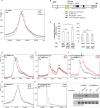Acylation of the Type 3 Secretion System Translocon Using a Dedicated Acyl Carrier Protein
- PMID: 28085879
- PMCID: PMC5279801
- DOI: 10.1371/journal.pgen.1006556
Acylation of the Type 3 Secretion System Translocon Using a Dedicated Acyl Carrier Protein
Abstract
Bacterial pathogens often deliver effectors into host cells using type 3 secretion systems (T3SS), the extremity of which forms a translocon that perforates the host plasma membrane. The T3SS encoded by Salmonella pathogenicity island 1 (SPI-1) is genetically associated with an acyl carrier protein, IacP, whose role has remained enigmatic. In this study, using tandem affinity purification, we identify a direct protein-protein interaction between IacP and the translocon protein SipB. We show, by mass spectrometry and radiolabelling, that SipB is acylated, which provides evidence for a modification of the translocon that has not been described before. A unique and conserved cysteine residue of SipB is identified as crucial for this modification. Although acylation of SipB was not essential to virulence, we show that this posttranslational modification promoted SipB insertion into host-cell membranes and pore-forming activity linked to the SPI-1 T3SS. Cooccurrence of acyl carrier and translocon proteins in several γ- and β-proteobacteria suggests that acylation of the translocon is conserved in these other pathogenic bacteria. These results also indicate that acyl carrier proteins, known for their involvement in metabolic pathways, have also evolved as cofactors of new bacterial protein lipidation pathways.
Conflict of interest statement
The authors have declared that no competing interests exist.
Figures





Similar articles
-
Transmembrane substrates of type three secretion system injectisomes.Microbiology (Reading). 2023 Jan;169(1):001292. doi: 10.1099/mic.0.001292. Microbiology (Reading). 2023. PMID: 36748571 Free PMC article. Review.
-
Deciphering the specific interaction between the acyl carrier protein IacP and the T3SS-major hydrophobic translocator SipB from Salmonella.FEBS Lett. 2020 Jan;594(2):251-265. doi: 10.1002/1873-3468.13593. Epub 2019 Sep 21. FEBS Lett. 2020. PMID: 31486064
-
Topological Analysis of the Type 3 Secretion System Translocon Pore Protein IpaC following Its Native Delivery to the Plasma Membrane during Infection.mBio. 2019 May 28;10(3):e00877-19. doi: 10.1128/mBio.00877-19. mBio. 2019. PMID: 31138750 Free PMC article.
-
Topology and Contribution to the Pore Channel Lining of Plasma Membrane-Embedded Shigella flexneri Type 3 Secretion Translocase IpaB.mBio. 2021 Dec 21;12(6):e0302121. doi: 10.1128/mBio.03021-21. Epub 2021 Nov 23. mBio. 2021. PMID: 34809452 Free PMC article.
-
The type III secretion system needle, tip, and translocon.Protein Sci. 2019 Sep;28(9):1582-1593. doi: 10.1002/pro.3682. Epub 2019 Aug 2. Protein Sci. 2019. PMID: 31301256 Free PMC article. Review.
Cited by
-
Role of CsrA in stress responses and metabolism important for Salmonella virulence revealed by integrated transcriptomics.PLoS One. 2019 Jan 25;14(1):e0211430. doi: 10.1371/journal.pone.0211430. eCollection 2019. PLoS One. 2019. PMID: 30682134 Free PMC article.
-
Recent insights into type-3 secretion system injectisome structure and mechanism of human enteric pathogens.Curr Opin Microbiol. 2023 Feb;71:102232. doi: 10.1016/j.mib.2022.102232. Epub 2022 Nov 9. Curr Opin Microbiol. 2023. PMID: 36368294 Free PMC article. Review.
-
Transmembrane substrates of type three secretion system injectisomes.Microbiology (Reading). 2023 Jan;169(1):001292. doi: 10.1099/mic.0.001292. Microbiology (Reading). 2023. PMID: 36748571 Free PMC article. Review.
-
Acyl Carrier Protein 3 Is Involved in Oxidative Stress Response in Pseudomonas aeruginosa.Front Microbiol. 2018 Sep 20;9:2244. doi: 10.3389/fmicb.2018.02244. eCollection 2018. Front Microbiol. 2018. PMID: 30294316 Free PMC article.
-
Calcium regulates the mycophagous ability of Burkholderia gladioli strain NGJ1 in a type III secretion system-dependent manner.BMC Microbiol. 2020 Jul 20;20(1):216. doi: 10.1186/s12866-020-01897-2. BMC Microbiol. 2020. PMID: 32689944 Free PMC article.
References
Publication types
MeSH terms
Substances
LinkOut - more resources
Full Text Sources
Other Literature Sources

